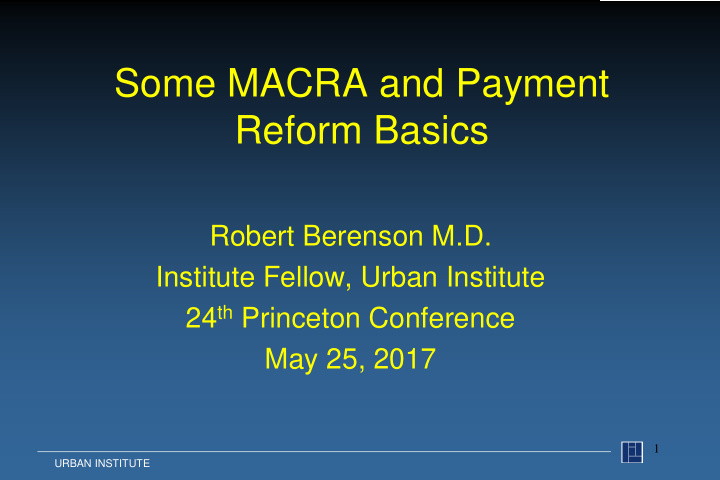



Some MACRA and Payment Reform Basics Robert Berenson M.D. Institute Fellow, Urban Institute 24 th Princeton Conference May 25, 2017 1 URBAN INSTITUTE
The Medicare Access and CHIP Reauthorization Act of 2015 (MACRA) 2 URBAN INSTITUTE
“Stabilizes” fee updates • Repeals the SGR, averting a 25% cut in fees, with a schedule of fixed, annual updates • July 2015-2019: annual fee update 0.5%, 2020-2025 0% – Payment increases (and decreases) take place through the MIPS (Merit-based incentive payment system) • Before 2025, 5 percent bonuses and exemption from MIPS for physicians who qualify as participating in AAPMs (advanced alternative payment models) • After 2025, 0.25% annual update; 0.75% if in an AAPM • These fixed, stable fee updates will likely produce an increasing gap between practice costs and revenues (given fairly flat service use in recent years) 3 URBAN INSTITUTE
The Merit-based Incentive Payment System • Combines the 3 current incentive programs: – Physician Quality Reporting System (PQRS) – quality – Value-Based Modifier (VBM) – quality & resource use – Meaningful Use (EHR), which CMS relabeled as Advancing Care Information • And adds a fourth, into a combined 4-part MIPS program – Clinical Practice Improvement Activities • Applies to payments after January 1, 2019 – the current programs are in use till then. Note that the increased financial impacts are delayed compared to prior law • Excludes physicians: – In their first year – With < 100 Medicare beneficiaries – With < $30,000 in Medicare allowed charges (was $10,000 in proposed rule) – The result is that almost 400,000 physicians are not initially subject to MIPS penalties (and bonuses) 4 URBAN INSTITUTE
MIPS assessment categories (percentages when fully phased in in 2022) • Quality -- 30% • Resource Use -- 30% • Advancing Care Information -- 25% • Clinical Practice Improvement Activities --15% – Such as expanding practice areas, population management, care coordination, beneficiary engagement, patient safety • For year 1, 2019, (with data collection starting 2017), CMS will not include any resource use rather than the 10% called for in statute, so instead will increase the quality component to 60% 5 URBAN INSTITUTE
MIPS payment adjustments • Negative adjustments capped – Those at 0-25% of threshold get maximum negative adjustment • 2019: - 4% • 2020: - 5% • 2021: - 7% • 2022: - 9% • Positive adjustments – Maximum: 3 X annual cap for the negative adjustment – so theoretically as much as 27% more if >25% above performance threshold • But total extra is funded at $500 million/ year going forward • The negative adjustments + the $500 million fund the bonuses – providers have to decide whether they are better off in MIPS or AAPMs – the prospect of as much as 27% upside is quite enticing. BUT ….. 6 URBAN INSTITUTE
CMS/LAN APM Framework 7 URBAN INSTITUTE
HHS Jan 26, 2015 Announcement of Goals and Timeline for Value Payments • 30% of traditional Medicare payments tied to value thru APMs (categories 3,4) by the end of 2016, and 50% by 2018 • 85% tied to value (categories 2-4) by 2016 and 90% by 2018 • Note that these assessments of value-based payment do not reflect the percentage of spending related to value, just whether any part of the payment approach has performance measurement and incentives for reducing spending -- even upside only
A few observations about the CMS/LAN Framework • Emphasizes theoretical incentives in payment methods, mostly ignoring the design and operational issues that determine whether payment models work as intended • Assumes that value derives only from 1) use of quality measures and 2) “non-nominal” risk-bearing • In short, the LAN Framework that classified 28 distinct payment models is useful for presenting a logical taxonomy based on structural features (measures and risk) but errs in implying that value follows the same continuum • Any payment method can be designed to produce more or less value – and that includes classic fee-for-service, in this case, the Medicare Physician Fee Schedule 9 URBAN INSTITUTE
Recommend
More recommend